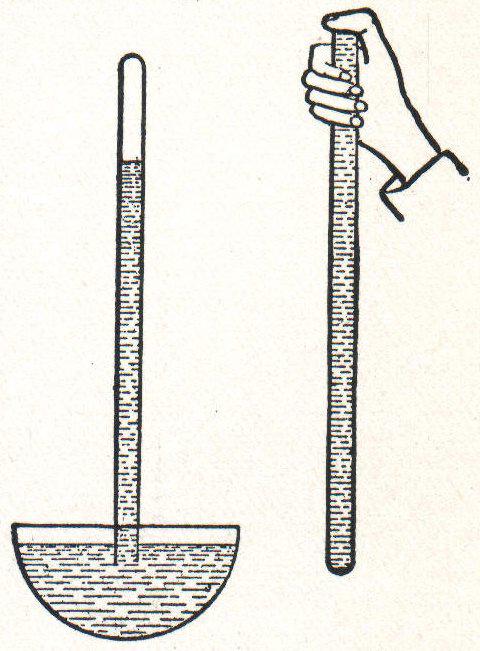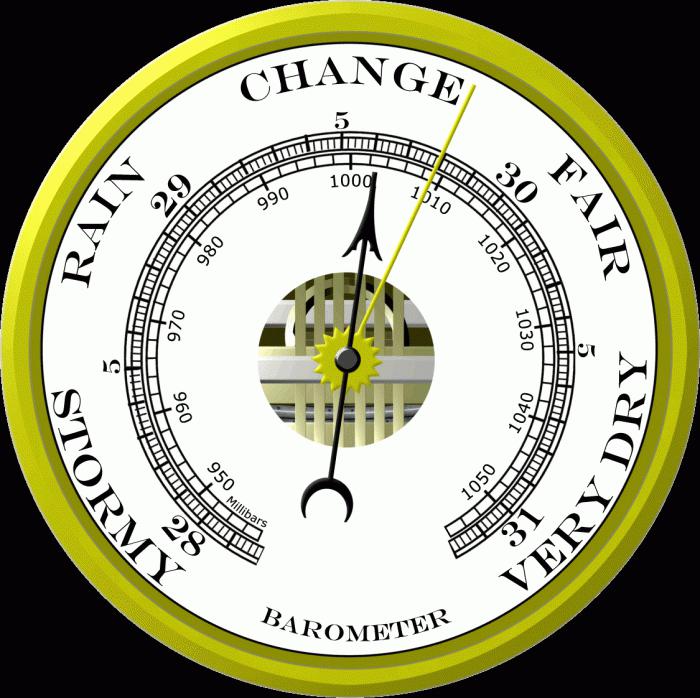
Atmosphere is the gas cloud surrounding the Earth.The weight of air, the height of the column which exceeds 900 km, has a powerful influence on the inhabitants of our planet. We do not feel this, taking life at the bottom of the air ocean as a matter of course. Discomfort people feel, climbing high in the mountains. The lack of oxygen provokes rapid fatigue. At the same time, the atmospheric pressure changes significantly.
Physics considers atmospheric pressure, its changes and its influence on the Earth's surface.

When do they start to study atmospheric pressure? Grade 6 - time to get acquainted with the peculiarities of the atmosphere. This process continues in the profile classes of the senior school.
The first attempts to establish atmospheric pressureair took in 1643 at the suggestion of the Italian Evangelista Torricelli. A glass tube welded from one end was filled with mercury. Closing the other side, it was lowered into mercury. In the upper part of the tube, as a result of the partial flow of mercury, an empty space was formed, called "the Torricellian emptiness".

By this time, natural science dominatedThe theory of Aristotle, who believed that "nature is afraid of emptiness." According to his views, there can be no space empty, not filled with matter. Therefore, the presence of a void in a glass tube for a long time tried to explain with other matter.
In the fact that this is an empty space, there is no doubt,it can not be filled with anything, since mercury completely filled the cylinder at the beginning of the experiment. And, flowing out, did not allow other substances to fill the vacant place. But why all the mercury did not pour into the vessel, because there are no obstacles to it either? The conclusion suggests itself: mercury in the tube, as in communicating vessels, creates the same pressure on mercury in the vessel, as well as something from the outside. At the same level, only the atmosphere is in contact with the mercury surface. It is her pressure that keeps the substance from pouring out under the influence of gravity. Gas, as is known, creates the same action in all directions. Its influence is exposed to the mercury surface in the vessel.

The height of the mercury cylinder is approximately 76 cm.It is noticed that this index varies with time, therefore, the pressure of the atmosphere changes. It can be measured in cm of mercury (or in millimeters).
The international system of units isinternational, therefore does not involve the use of millimeters of mercury. Art. when determining the pressure. The unit of atmospheric pressure is established in a manner analogous to that in solids and liquids. The pressure measurement in pascals is taken in SI.
For 1 Pa, a pressure is taken which is created by the force of 1 N per 1 m2.
We define how the units of measure are related. The pressure of the liquid column is set according to the following formula: p = ρgh. Density of mercury ρ = 13600 kg / m3. For the reference point, let us take a mercury column 760 millimeters long. From here:
p = 13600 kg / m3× 9.83 N / kg × 0.76 m = 101292.8 Pa
To record the atmospheric pressure in pascals, we take into account: 1 mm Hg. = 133.3 Pa.
Determine the force with which the atmosphere acts on the surface of the roof with dimensions of 10x20 m. The atmospheric pressure is assumed equal to 740 mm Hg.
p = 740 mm Hg, a = 10 m, b = 20 m.
To determine the strength of action, it is necessary to establish the atmospheric pressure in pascals. Considering that 1 millimeter of mercury. is equal to 133.3 Pa, we have the following: p = 98642 Pa.
We use the formula for determining the pressure:
p = F / s,
Since the roof area is not given, assume that it has the shape of a rectangle. The area of this figure is determined by the formula:
s = ab.
Substitute the area in the calculation formula:
p = F / (ab), from which:
F = pab.
We calculate: F = 98642 Pa × 10 m × 20 m = 19728400 H = 1.97 MN.
Answer: the pressure of the atmosphere on the roof of the house is 1.97 MN.
Experimental determination of atmospheric pressurecan be performed using a mercury post. If a scale is attached to it, then it becomes possible to record the changes. This is the simplest mercury barometer.
He was surprised to note the changes in the atmosphere of the Evangelista Torricelli, linking this process with heat and cold.

It is known that mercury is harmful enough forhuman health. As a result, open mercury barometers can not be used. Other liquids have a density much less, so a tube filled with liquid must be long enough.
For example, the water column created by Blaise Pascal should be of the order of 10 m in height. The disadvantage is obvious.
A remarkable step forward is the idea of moving away from the fluid when creating barometers. The possibility to make a device for determining the pressure of the atmosphere is realized in barometers-aneroids.

The main part of this meter is flata box from which air is pumped out. To ensure that it is not crushed by the atmosphere, the surface is made corrugated. The spring system of the box is connected to an arrow indicating the pressure value on the scale. The latter can be graduated in any units. The atmospheric pressure in pascals can be measured with an appropriate measuring scale.
The change in atmospheric density as the riseup leads to a decrease in pressure. The inhomogeneity of the gas shell does not allow us to introduce a linear law of variation, since with increasing altitude the degree of decrease in pressure decreases. At the surface of the Earth as the rise for every 12 meters, the effect of the atmosphere falls by 1 mm Hg. Art. In the troposphere, a similar change occurs at every 10.5 m.
Near the surface of the Earth, at the altitude of the flight of the aircraft, an aneroid equipped with a special scale can determine the altitude by atmospheric pressure. This device is called an altimeter.

A special device on the surface of the Earth allows you to set the altimeter reading at zero, in order to use it later to determine the lift height.
At the foot of the mountain, the barometer showed an atmospheric pressure of 756 millimeters of mercury. What is the significance at 2500 meters above sea level? It is required to record atmospheric pressure in pascals.
R1 = 756 mm Hg, H = 2500 m, p2 -?
To determine the barometer readings at a height of H, we take into account that the pressure drops by 1 millimeter of mercury. every 12 meters. Consequently:
(R1 - R2) × 12 m = H × 1 mmHg, from where:
R2 = p1 - Н × 1 mm of mercury / 12 m = 756 mm of mercury. - 2500 m × 1 mm Hg / 12 m = 546 mm Hg.
To record the atmospheric pressure obtained in pascals, we perform the following actions:
R2 = 546 × 133.3 Pa = 72619 Pa
Answer: 72619 Pa.
The movement of air atmospheric layers near the surface of the Earth and the inhomogeneous heating of air in different areas lead to a change in weather conditions on all parts of the planet.
The pressure can vary by 20-35 mm Hg. in a long period and 2-4 millimeters of mercury. during the day. A healthy person does not perceive changes in this indicator.
Atmospheric pressure, the value of which is lower than normal and often changes, indicates a cyclone covering a certain one. Often this phenomenon is accompanied by cloudiness and precipitation.
Low pressure is not always a sign of rainy weather. Hate is more dependent on the gradual decline of the indicator in question.

Change the weather for the better can be determined by the following features:


























